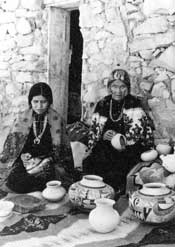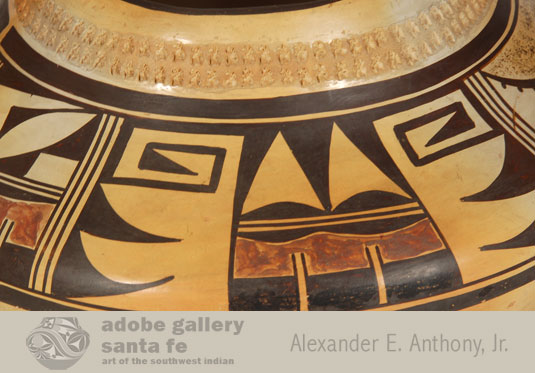Hopi-Tewa Nampeyo Jar with Hopi Village Label [SOLD]
+ Add to my watchlist Forward to Friend
- Category: Historic
- Origin: Hopi Pueblo, Hopituh Shi-nu-mu
- Medium: clay, pigment
- Size: 5-1/2” height x 10-3/4” diameter
- Item # C3924C SOLD
Up until near the end of the nineteenth century, all pottery from the Hopi Mesas was utilitarian and is reported to have been made at all the villages. The year 1875 was the beginning of change. That was the year Thomas Varker Keam established the first trading post east of First Mesa. He encouraged the potters to produce pottery for sale and trade, both for the benefit of the potters to earn income and for him to have products to sell. It is well-known that Keam was responsible for the transition from utilitarian wares to saleable wares. Allen 1984:18
 By 1890, Keam has amassed a large collection of Hopi material culture at his trading post. He catalogued over 3,000 baskets, tabletas, and ceremonial items as well as fifteen hundred ceramic vessels. He amassed this collection at the request of Mary Hemenway, a wealthy Bostonian, and it is known as the Keam Collection, and is now in the Peabody Museum at Harvard University. Keam also provided collections to other museums, both in the United States and abroad. He amassed over 2,000 ceramics in less than four years. Certainly, some of these were from Nampeyo. Allen 1984:18
By 1890, Keam has amassed a large collection of Hopi material culture at his trading post. He catalogued over 3,000 baskets, tabletas, and ceremonial items as well as fifteen hundred ceramic vessels. He amassed this collection at the request of Mary Hemenway, a wealthy Bostonian, and it is known as the Keam Collection, and is now in the Peabody Museum at Harvard University. Keam also provided collections to other museums, both in the United States and abroad. He amassed over 2,000 ceramics in less than four years. Certainly, some of these were from Nampeyo. Allen 1984:18
“Nequatewa states in his biography of Nampeyo that ‘when she became a young maiden she was as good a potter as any in Walpi, and she did all the decorating for the old lady, her father’s mother, a Tewa lady and her teacher, as she had become a good pottery designer.’ He went on to say that ‘when the stores were established on the reservation by the white traders, she was doing a good deal of pottery work, so that when the stores began to trade for pottery, her work was among the best, and she was getting good prices.’” Allen, 1984:21
By 1900, the Polacca Polychrome pottery of the past was no longer being made, instead what replaced it was a yellow ware with black and red painted designs, with a slip that did not crackle like the Polacca slip. It was then that Nampeyo was encouraged to reproduce pottery of the style being excavated. She, instead, used those excavated ceramics as inspiration for her work. She was not interested in copying others.
Keam sold his trading post to Lorenzo Hubbell in 1902 and returned to his home in England. While he had the post, he accumulated hundreds, if not thousands of Hopi ceramics, and certainly many were from Nampeyo. She was recognized as the best potter on the Hopi Mesas and was busy supplying Keam with pottery. This jar is certainly one made by her when she was in her prime. The painting application was perfectly symmetrical, crisp, consistent in thickness and beautifully positioned. The indentations around the rim were carefully placed in alignment and with the same pressure.
Trader’s routinely placed paper labels on pottery surfaces, something no one would do today. Those labels, however, tell a story. This one has a label stating From the Hopi Villages and a price of $1.50. That is probably a price from 1900-1905. Unfortunately, that price is not valid today.
Condition: very good condition
Provenance: this Hopi-Tewa Nampeyo Jar with Hopi Village Label is from a private collection
References:
- Allen, Laura Graves. Contemporary Hopi Pottery, Museum of Northern Arizona, Flagstaff. 1984.
- Nequatewa, Edward. “Nampeyo, Famous Hopi Potter 1859? - 1942.” Plateau Vol. 15, No. 1, Museum of Northern Arizona, Flagstaff. 1942.
Source Image (upper left): courtesy of Rick Dillingham. Fannie is to the left Nampeyo is to the right. Fourteen Families In Pueblo Pottery.

- Category: Historic
- Origin: Hopi Pueblo, Hopituh Shi-nu-mu
- Medium: clay, pigment
- Size: 5-1/2” height x 10-3/4” diameter
- Item # C3924C SOLD



